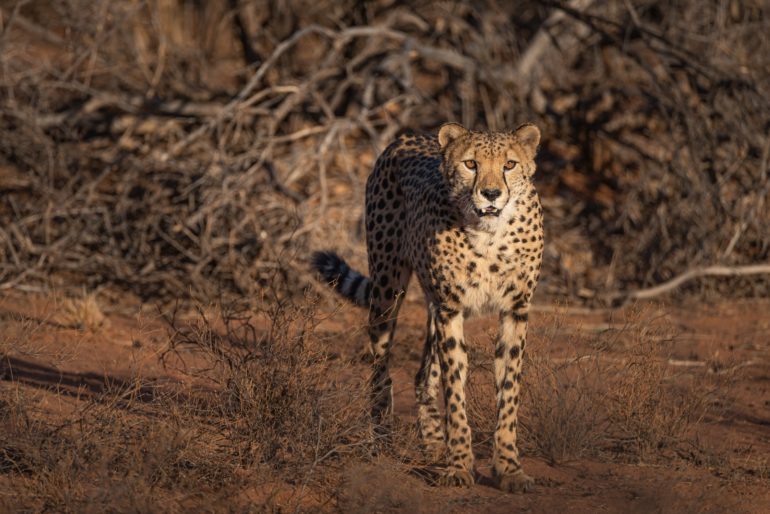Rural central Namibia is one of the most important strongholds of the declining global cheetah population. Here, the rarest large African cat lives on privately owned farmland. A traditional conflict poses a threat to them, as they occasionally prey on cattle calves and are therefore rarely welcomed on the farms. New insights into the cheetah’s spatial behavior provide a viable solution to this human-wildlife conflict: In the core areas of male cheetah territories all local males and females frequently meet to exchange information. This results in hotspots of cheetah activity in these “communication hubs” and in substantially less activity in the vast areas between the core areas of the territories. Implementing this knowledge and moving their breeding herds with young calves out of these hotspots, farmers were able to reduce livestock losses by more than 80 percent. These insights are the result of a close and trusting cooperation between scientists from the Leibniz Institute for Zoo and Wildlife Research (Leibniz-IZW) and farmers in central Namibia. They are published in the scientific journal Proceedings of the National Academy of Sciences.
The cheetah (Acinonyx jubatus) is the rarest big cat species in Africa and its numbers have substantially decreased over the last decades to now less than 7,000 adult individuals. In central Namibia, one of the most important strongholds of the species, the cheetahs live on privately owned farmland, not inside protected areas. This has caused conflict with cattle farmers on whose calves the cheetahs occasionally prey. In the past, they have been removed repeatedly by farmers. “This conflict is an important reason for the decline of the Namibian cheetah population, thus solutions to this conflict that are viable for both farmers and cheetahs needed to be developed,” says Dr. Jörg Melzheimer, spatial ecologist of the Leibniz-IZW Cheetah Research Project (CRP) in Namibia, which is primarily funded by the Messerli Foundation from Switzerland. To find such solutions, the CRP started a research program on the spatial ecology of cheetahs in 2002 and established a trusting collaboration with many farmers in Namibia. “Supported by the farmers we caught more than 250 cheetahs and equipped many of them with high resolution GPS collars to thoroughly analyze their spatial behavior,” adds Dr. Bettina Wachter, head of the CRP. The collars recorded an average of 96 GPS coordinates per day per cheetah, or several million individual locations across all individuals.
With the help of this enormous dataset, the Leibniz-IZW scientists identified two distinct spatial tactics of male cheetahs. Approximately one third of all males own small territories which they scent-mark at 20 to 40 prominent landmarks such as trees, rocks or termite mounts in the core area. Other males, called floaters, do not own a territory but roam over vast areas. “The territories are not contiguous, but spread evenly across the landscape with a lot of open space between them,” Melzheimer explains. “Floaters visit the core areas of the territories frequently to gather information on the current territory holders and to consider their chances of queueing for territory ownership or winning a fight for the territory. At the same time, the females regularly visit these areas in search of mating partners.” As a consequence, the core areas of the territories function as communication hubs for the local cheetah population and are effectively hotspots of cheetah activity.
These communication hubs are typically 25 square kilometers in size, situated 20 to 25 kilometers apart and thus make up only 10 percent of the total area. They represent areas with a high local predation risk for livestock, whereas the remaining lands between communication hubs make up 90 percent of the total area and entail only a low predation risk. Although the communication hubs cover only a small part of the study area, mapping of all hotspots revealed that about 30 percent of the cattle farmers are affected to varying degrees by cheetah activity.
Based on these findings the Leibniz-IZW scientists designed an experiment together with the farmers. Where the farmers unwittingly kept breeding herds with young calves within the communication hubs, the scientists suggested to move them to areas with much less cheetah activity. “These experiments were highly successful and reduced the livestock losses of farmers by more than 80 percent,” Melzheimer and Wachter sum up. “We demonstrated that cheetahs did not follow the breeding herds, but maintained their spatial system of communication hubs and instead preyed on wildlife occurring naturally on the farms in the hotspot locations. This implies that there are no problem cheetahs, but problem areas with high predation risk.”
The key to the new scientific results and their application to the farmer-cheetah conflict was a long-term collaboration of the scientists with the cattle farmers in central Namibia. This collaboration was based on the concept of a ‘real-world laboratory’ where scientists and farmers formulate research questions and goals together, co-develop a research design, collaborate on capturing and collaring cheetahs and collecting data on livestock losses, and thereby co-create knowledge and potential solutions to the conflict. “This allowed us to work as partners on a real-world problem and to find solutions together, as well as to communicate them in the relevant communities, thereby helping to spread the successful application of the solutions,” Melzheimer explains. “The future of the cheetah does not lie in the hand of scientists or conservationists, it depends on all stakeholders working together on viable solutions.”
Researchers study the spatial behaviour of male cheetahs
More information:
Joerg Melzheimer el al., “Communication hubs of an asocial cat are the source of a human–carnivore conflict and key to its solution,” PNAS (2020). www.pnas.org/cgi/doi/10.1073/pnas.2002487117
Provided by
Forschungsverbund Berlin e.V. (FVB)
Citation:
Hotspots of cheetah activity is a key to solving the cheetah-farmer conflict in Namibia (2020, December 7)
retrieved 7 December 2020
from https://phys.org/news/2020-12-hotspots-cheetah-key-cheetah-farmer-conflict.html
This document is subject to copyright. Apart from any fair dealing for the purpose of private study or research, no
part may be reproduced without the written permission. The content is provided for information purposes only.



